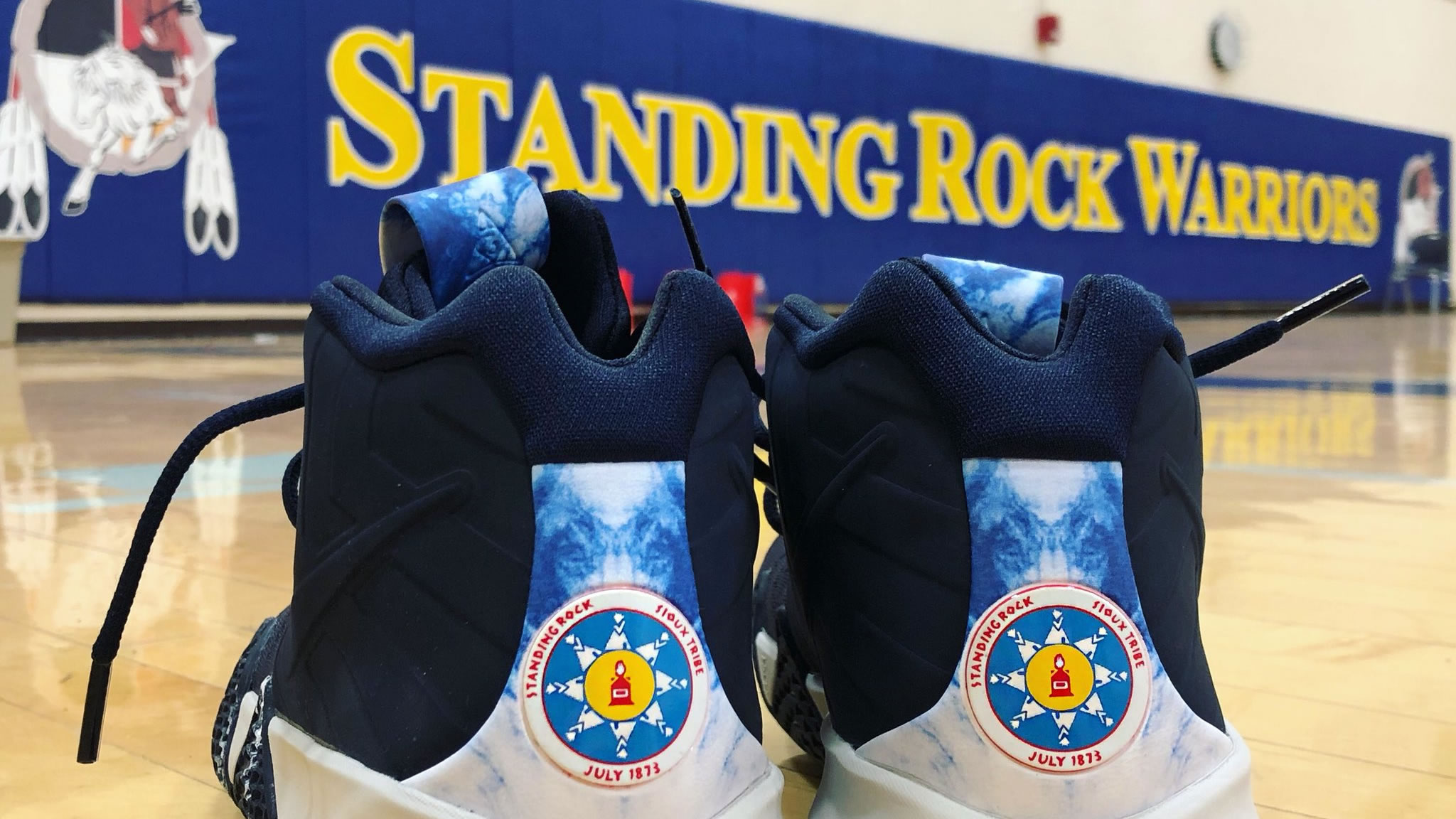 |
| Kyrie and Asia Irving (Standing Rock) |
Kyrie [Irving] stunned members of the tribe in 2016 when he said in an interview with ESPN that his mother Elizabeth was a member. That sent the elders scrambling to identify a lineage, and they found his grandparents and great-grandparents from the White Mountain family in the Standing Rock reservation in South Dakota.
Irving supported the tribe’s fight against the Dakota Access Pipeline in 2016 and has had the tribe’s logo tattooed on the back of his neck. Earlier in 2018, he released a version of his Nike signature shoe that featured the logo as well. In 2017, Irving made a six-figure donation to the tribe.
The tribe and Irving have been working since April to put together a time for him to come and take part in a naming ceremony, which is sacred in Native American culture.
In Lakota, Irving’s name, ‘Little Mountain’ is ‘Hela’ (roughly: HEY-law), and his sister, Asia’s, name, ‘Buffalo Woman’, is ‘Tatanka Winyan’ (roughly: ta-TONG-ka WIN-yan). ‘Winyan’, ‘woman’, is perhaps most familiar to the rest of us in the derived form used to refer to one’s oldest daughter: ‘Winona’. ESPN
Kyrie had apparently known of his tribal heritage for a while before acknowledging it publicly during the Dakota Access Pipeline protests in 2016. His mother was adopted out of the tribe as a child, a practice that was common at the time, but which was sharply curtailed by the Indian Child Welfare Act in 1978.
On his mother’s side, Kyrie and his sister are members of White
Mountain family which is itself a part of the Hunkpapa band of the
Lakota Sioux; Sitting Bull is probably the best known member of the band.
The tribe occupies some of the worst land in the Dakotas. The Sioux
were, according to the 1868 Laramie Treaty, granted all of Dakota
Territory west of the Missouri River, including the Black Hills. When
George A. Custer’s expedition confirmed that there was gold in the
Hills, the Army first put up a half-hearted effort to keep trespassers
out of the Hills, before taking possession of them and protecting
prospectors and others from the Lakota who objected to their presence.
Although the US had de facto, if not de jure, possession of the Black
Hills, they were content to leave the rest of the Lakota reservation
alone. However, passage of the Dawes act–which most famously opened up Oklahoma for homesteaders–led to a similar gutting of reservation lands in South Dakota.
What was left for Natives was the most unproductive land available.
Such members of the tribes as had an inclination to learn how to farm
and raise stock were forced to do so on the most marginal of land which
was marginal for those purposes to begin with. The South Dakota
Badlands, for example, occupy about a third of the land allocated to the
bands of the Pine Ridge reservation.
At present, only about one out of a thousand U.S. citizens identify
as Native American and their suffering is more or less invisible to the
rest of the country. Life expectancy for those born onto the Pine Ridge reservation is less than 67 years. Unemployment is reportedly 60% on the Standing Rock, where 40% of the population is below the poverty line.
The pipeline protests of 2016 are perhaps illustrative of the
occasional interest shown in Native issues. For a short period, any
number of people embraced some Native phrases, and camped out along the
Missouri River professing solidarity. When the protests ended, they left
behind a gigantic mess and more or less forgot about the tribe, having
done absolutely nothing to improve the plight of the people they were
ostensibly there to support.
This is not a post about political parties, about who’s right and
who’s wrong. This isn’t about blaming people of one particular set of
political beliefs for a course of neglect and mistreatment that has gone
on for over 200 years and for which people of all political stripes
bear a measure of responsibility. This post is about the manifest
suffering of ethnic groups that were more or less wiped out by the
United States over the course of a century. It’s about the horrific world of Indian Health Services, the mismanagement of trust funds, and broken treaties.
What you choose to do with this information is up to you, but you need to know what life is like on these reservations.
source
 |
| Kyrie and his mom Elizabeth. Elizabeth died from sepsis at a young age of 29. She was survived by her husband Drederick and their two kids – a son Kyrie and his sister Asia. |
In spite of her early death, Elizabeth did a lot. She was a woman of an interesting and troubled fate.
She was born as Cynthia Jeannette Mountain. Her biological mother gave her for adoption. Thus, Kyrie’s mother got new parents and a new name – Elizabeth Ann Larson. She grew up in the family of a pastor and Lutheran minister George Larson and his wife Norma. She moved a lot in her childhood and teen years because of her father’s job.
After graduation from school she entered Boston University, where played for the local volleyball team. She was a brilliant student with open modern views and dreamed to become the first female president. After graduation she earned her living as a pianist, and was really talented in it. She could play by ear any melody.
Elizabeth tied a knot with Drederick Irving in 1990. They lived
together during 6 years and gave a birth to a daughter and a son. She
died six years later from skin disease. Source









No comments:
Post a Comment
tell us your thoughts!